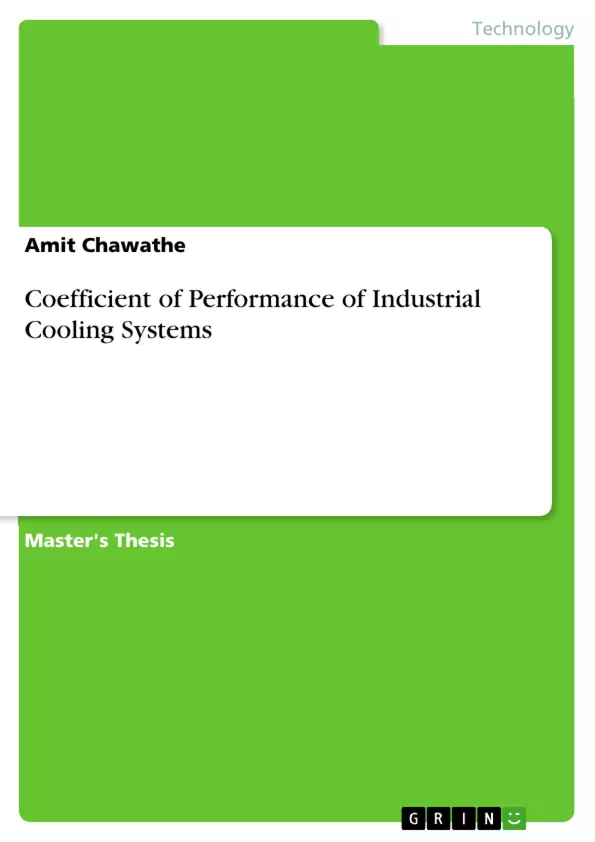Chiller plant systems often have the highest consumption of energy in a facility. Hence, it becomes essential for estimating the coefficient of performance (COP) of an industrial cooling system to ensure efficient use of resources. Various chiller plant systems have been analyzed to establish techniques or methodologies for determining the COP. Performance degradation with age and recent new technologies create an enormous range of COPs from 2 to 8 or more. After analyzing, it is found that the critical parameter for determining the COP of any type of chiller plant system is the mass flow rate. Remarkably, many industrial cooling systems do not measure mass flow rate in any part of the chilled water system and therefore cannot calculate COP. Good energy efficiency practice then requires that techniques be developed to estimate mass flow rate in industrial cooling systems in situ, without shutting down the system and installing measurement equipment.
Three methodologies have been examined for measuring the mass flow rate of the condenser water loop. The first method looks at the cooling tower part of the condenser water loop to determine the mass flow rate of the condenser water by isolating some of iii the valves. The second method makes use of pump curves with relation to the differential pressure to calculate the flow rate of either the chilled water or the condenser water. Lastly, an ultrasonic flow meter is considered as a means to determine the flow rate in a running system. The mass flow rate is then used in the estimation of COP of the chiller cooling tower system.
Table of Contents
- Abstract of the thesis
- List of Tables
- List of Figures
- Chapter 1.
- Introduction
- Literature Review
- Types of Chillers
- Overview of Cooling Towers
- Factors affecting the efficiency of chiller plant system
- Coefficient of Performance
- Conventional methods of finding the mass flow rate
- Problem Statement
- Overview of the objective
- Chapter 2.
- Experimental Procedure
- Cooling Tower experiment procedure
- Pump Curve methodology
- Ultrasonic flowmeter technique
- Chapter 3
- Results and Discussion
- Cooling tower experiment results
- COP estimation from Pump Curve
- Flow rate determination by ultrasonic flowmeter
- Chapter 4
- Conclusion and Future scope
- References
- LIST OF TABLES
Objectives and Key Themes
This thesis investigates techniques for accurately estimating the Coefficient of Performance (COP) of industrial cooling systems. The primary objective is to develop methodologies for determining mass flow rate, a crucial factor in COP calculation, without requiring system shutdown or installation of dedicated measurement equipment. The research explores practical applications of various techniques, including cooling tower analysis, pump curve methodology, and ultrasonic flowmeter technology.
- Accurate COP Estimation in Industrial Cooling Systems
- Mass Flow Rate Determination without System Interruption
- Comparison and Evaluation of Different Estimation Techniques
- Practical Application of Cooling Tower Analysis, Pump Curve Methodology, and Ultrasonic Flowmeters
- Energy Efficiency Improvement in Chiller Plant Systems
Chapter Summaries
Chapter 1 introduces the topic of COP estimation in industrial cooling systems, providing a comprehensive overview of relevant literature, chiller types, cooling towers, and factors influencing system efficiency. The chapter also establishes the problem statement and outlines the objectives of the research. Chapter 2 delves into the experimental procedures employed in the study, covering the methodologies used for cooling tower analysis, pump curve determination, and ultrasonic flowmeter measurements. Chapter 3 presents the results of the experiments and discusses the findings in detail, highlighting the effectiveness and limitations of each technique.
Keywords
This thesis focuses on the crucial topic of energy efficiency in industrial cooling systems. The research revolves around the concept of Coefficient of Performance (COP) and its relationship to mass flow rate. Key themes include the development and evaluation of techniques for estimating mass flow rate without system shutdown, using methodologies like cooling tower analysis, pump curve determination, and ultrasonic flowmeter technology. Practical applications and efficiency improvements in chiller plant systems are also central to this work.
- Quote paper
- Amit Chawathe (Author), 2020, Coefficient of Performance of Industrial Cooling Systems, Munich, GRIN Verlag, https://www.grin.com/document/1438801



